|
July 29, 2020
I hope that you and your loved ones are doing well, staying healthy, and looking out for your neighbors and friends.
Our statewide positivity rate today has again moved below 5%, an important goal for school reopening. However, we’re still seeing troubling lagging indicators from earlier increases, with 9 deaths and more than 30 new hospitalizations.
In this newsletter you’ll find lots more detail about where we are as a state, thanks to the Weekly COVID Data Report. You’ll also see a chart that tells you where each county is right now in terms of the metrics required for in-person school reopening. Finally, more info about the legislative work on policing and reforming use of force.

TODAY’S CORONAVIRUS AND CORONAVIRUS RESPONSE UPDATE
-
Positive Cases: OHA reports that 269 additional Oregonians have tested positive for COVID. The cumulative total for those testing positive is 16,815.
-
Total Tests: The number of tests has increased by 6,463. The cumulative total is now 393,249.
-
Ratio: The percentage of positive tests remains at 4.2% of total results. The national percentage today is 7.9%.
-
Deaths: I’m sorry to report 8 additional deaths due to the coronavirus today. The total number of deaths in Oregon is now 311.
-
Hospitalized: OHA is reporting an additional 31 COVID hospitalizations. The cumulative number of those have been hospitalized with COVID is now 1,568.
-
Presumptive Cases: OHA is including “presumptive COVID-19 cases” in its daily reports, consistent with recently amended guidance from the Centers for Disease Control and Prevention. A presumptive case is someone who does not yet have a positive PCR test result but is showing symptoms and has had close contact with a confirmed case. If they later test positive by PCR, those will be recategorized as confirmed cases. Today’s number of new presumed positives is 35. The total number of presumed positives is now 906.
-
Other Hospital Information:
- Patients Currently w COVID-19 Symptoms (who may or may not have received a positive test result yet): 235 (5 more than yesterday). Of those, 163 have already received a positive test back.
- Available ICU Beds: 163 (30 more than yesterday).
- Other Available Beds: 737 (15 fewer than yesterday).
- ICU Patients w COVID-19 Symptoms: 62 (4 more than yesterday).
- COVID-19 Patients Currently on Ventilators: 32 (1 more than yesterday).
- Available Ventilators: 775 (2 more than yesterday).
-
Dashboards
-
Today’s National Numbers:
-
PPE:
-
Additional Brief Items:
- Employment Department Interim Director David Gerstenfeld gave his weekly briefing to the press today. He reported that last week they were able to process 21,000 initial PUA claims. That’s nearly double the rate from the week before, and five times more than the weekly rate at the start of the Focus PUA project. He believes that they are now on track to meeting their August 8 deadline to complete Focus PUA. To learn more, you can watch his briefing here or listen to it here. Also, if you’re interested, here again is a link to tomorrow's PUA webinar.
- If you missed this morning’s OHA Facebook Live Q&A on COVID Testing, you can rewatch the video here.
How to Track Counties’s Status on Meeting the In-Person Schooling Thresholds
In yesterday’s newsletter I reported on the new "Ready Schools, Safe Learners: Community COVID-19 Metrics" policy from OHA and the Oregon Department of Education. It shows the necessary metrics that must be met for schools to resume in-person classes and to remain open. To begin in-person instruction, the county must have a weekly case rate at or below 10 per 100K for three weeks in a row, along with a test positivity rate at or below 5%. Under certain circumstances the rates can be higher than that, as the policy report explains.
I mentioned yesterday that the OHA will be producing regular updates of where the counties are on these metrics, and they have done so. You can see it below, and follow it as it’s updated each week in the Oregon COVID-19 County Metrics by Week report.
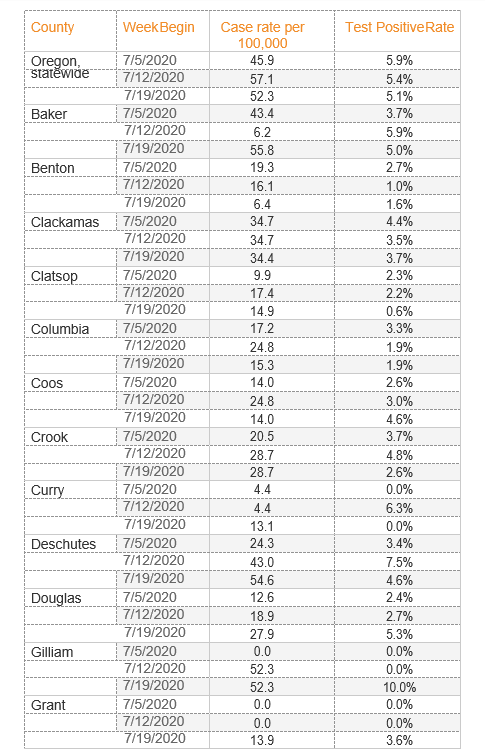   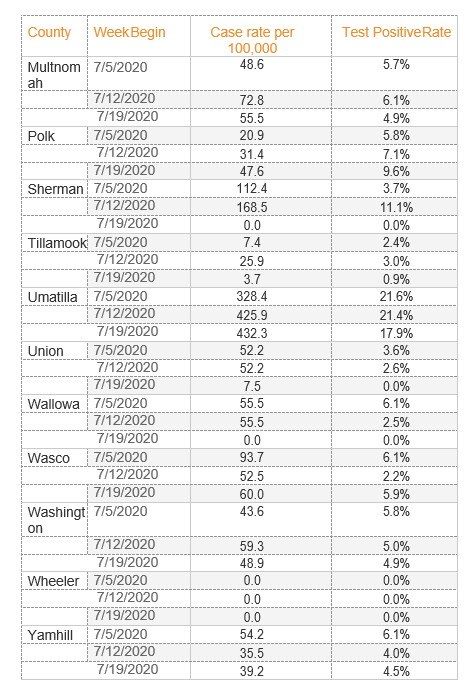
Latest OHA Weekly COVID Report Released
OHA released its weekly COVID report today. It is again a very comprehensive snapshot of different aspects of transmission of the disease in Oregon.
Here are some of OHA’s broad observations of where we are now, based on data from July 20-26:
- We are continuing to see an increase in cases, but the rate of increase is slowing.
- The percentage of positive test results declined for the first time in many weeks, from 6.6% to 5.1%.
- The statewide infection rate is now 40 cases per 10,000 Oregonians (up from 35 cases).
- 27 Oregonians were reported to have died last week, up from 25 the previous week.
- A record weekly number of 42,452 COVID tests was reported, up from the previous week’s record of 37,137.
- Hospitalizations are rising again, with the peaks similar to those in March and April.
- However, OHA continues to believe that the hospital rates are lower than they would be if the increases in new infections weren’t largely among young people.
- We’re still seeing large outbreaks at workplaces and long-term care facilities but they are a smaller proportion of the overall new cases.
- OHA believes that this is due to a combination of better contact tracing and containment of workplace outbreaks and an increase in what OHA calls “sporadic cases,” which suggests that the disease is spreading more broadly into the community.
The report again provides information about signs, symptoms, and risk factors; racial/ethnic/age/gender demographics; recovery; outbreaks in long-term care; workplace outbreaks; hospital rates; and the breakdown of cases by zip code.
Racial/Ethnic
The report again demonstrates significant disparities among racial groups. You can see this in the charts below, with data that I’ve taken from the July 15 report, the July 22 report, and from this report. It allows you to see at a glance the proportion of case counts within different racial groups and ethnic groups (technically, “Hispanic” is not a race and is counted as an ethnic group, with numbers from a separate chart).
You’ll see again how much higher the rates per 10,000 are for most racial/ethnic groups compared to White Oregonians. Black Oregonians are a little over four times more likely to contract the disease than are White Oregonians, Native Americans also more than four times more likely, Latinx Oregonians are six times more likely, and Pacific Islanders an incredible 12 times more likely. You’ll also again see that the percentages of those hospitalized or dying from the disease are lower for non-Whites than for the population of White Oregonians (the exception is the hospitalization rate for Pacific Islanders, which is slightly higher). The percentage of infections that lead to hospitalizations has pretty much stabilized.
The OHA has confirmed that this may be a function of age: many of those contracting the virus via workplace outbreaks are from BIPOC (Black, Indigenous, People of Color) populations. These frontline workers at care centers and food processing centers tend to be younger and thus somewhat less likely to experience severe consequences from the disease.
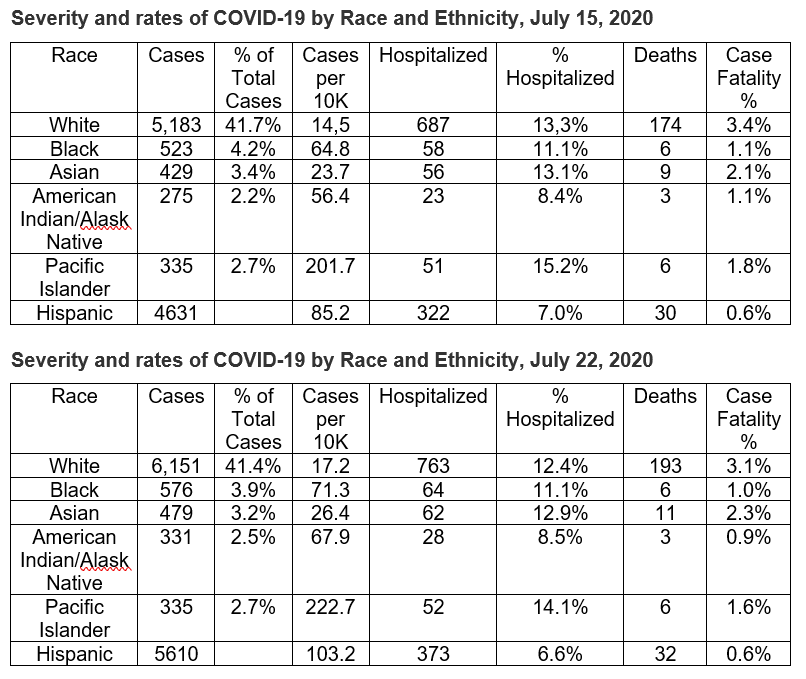 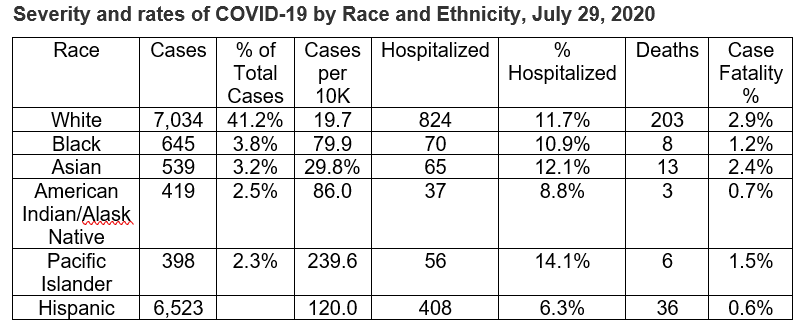
Long-Term Care Facilities
We appear to be seeing a gradual slowing down of outbreaks in long-term care facilities, with more facilities moving from “active” to “resolved” status.
This week’s report lists outbreaks in 35 (up from 29) long-term care facilities that are still considered active. They are responsible for 531 cases (up from 416) and 46 deaths (up from 44). In addition, there are 49 outbreaks considered resolved (up from 45). They are responsible for 809 cases (down from 816) and 120 deaths (up from 119).
The total for active and resolved facilities is thus 1,354 cases (up by 122 from last week) and 166 deaths (up by 16 from last week). Deaths of residents in long-term care constitute a little more than half of all COVID deaths in Oregon.
The listed facilities include all where there was at least one death and at least three cases, so the above total should include all of the deaths in Oregon, but there may be additional cases out there that are not included.
Workplace Outbreaks
Similarly, there are separate listings for workplace outbreaks that are “active” and “resolved,” but without deaths identified by workplace. So far, eight deaths have been the result of workplace outbreaks, a figure unchanged for quite some time.
You’ll find 63 workplaces listed as “Active” this week, totaling 1,733 cases. Fifty-two are listed as “Resolved,” totaling 692 cases. The total for both is 2,425.
Those listed include workplaces with at least 5 cases identified among workers or family members. They are listed in descending order of number of cases.
OHA points out that the higher number of COVID cases among people of color can in part be tied to their being overrepresented in agricultural and correctional settings, where it’s difficult to contain the spread of the virus.
Childcare Outbreaks
The Weekly Report again includes names and case counts for child care facilities that enroll 30 or more children and have five or more cases. KinderCare in Lake Oswego and a facility in Nyssa in Malheur County are again listed, along with Hall Boulevard KinderCare in Tigard. A fourth has been added: Trout Creek Bible Camp in Corbett, the second largest at 19.
The Weekly Report also includes the total number of facilities statewide—no matter how many children they enroll—that have five or more cases. There have been two such facilities. That’s the same number as last week.
Infections by Zip Code
You’ll see that the zip code list again reveals the various hot spots around the state, presented in terms of cases per 10K residents. The top five should come as no surprise:
- 97761 (Warm Springs in Jefferson County)
- 97838 (Hermiston in Umatilla and Morrow Counties)
- 97818 (Boardman in Morrow County)
- 97882 (Umatilla in Umatilla County)
- 97875 (Stanfield in Umatilla County)
Four out of the top five zip codes are again where food processing workers in the Morrow/Umatilla area live. Newport in Lincoln County dropped off the list this week (they’re #6).
Here is a zip code locator for you to use as you look at the zip code numbers.
Legislative Work On Police Reform Continues
The Joint Committee charged with pursuing ways to improve policing and use of force met again this morning, discussing and hearing testimony on use of tear gas and other “non-lethal” weapons, demilitarizing police uniforms, and making sure that the public can easily identify individual police officers. It was a good discussion, with plenty of back-and-forth among committee members. I know that the testimony and discussion will lead to further improvements in the bills. If you’d like to listen to the hearing, go to today's agenda page and click on the “Play” icon at the top or on the side.
The hearings continue tomorrow and Friday.
If you go to any of the agenda pages linked below and then scroll down, you’ll find information on how to sign up to speak remotely or to submit written comment. You’ll also find links under MEETING MATERIALS to testimony that has already come in.
Here’s the schedule for the remainder of this week’s hearings:
THURSDAY, JULY 30
FRIDAY, JULY 31
Where Are Today’s New Cases?
If we put together the positive test results and new “presumptive” cases reported today, the overall number of new cases is 304. A little over half of the state’s new cases today are from the Portland Tri-County region. Here is the breakdown by county for today:
Benton (3)
Clackamas (28)
Clatsop (1)
Coos (3)
Crook (3)
Deschutes (16)
Douglas (2)
Hood River (7)
Jackson (13)
Jefferson (5)
Josephine (4)
Klamath (2)
Lane (13)
Lincoln (2)
Linn (1)
Malheur (20)
Marion (20)
Morrow (5)
Multnomah (82)
Polk (4)
Umatilla (4)
Union (1)
Wallowa (1)
Washington (51)
Yamhill (13)
And the Deaths
Oregon’s 304th COVID-19 death is a 72-year-old man in Multnomah County who tested positive on July 10 and died on July 23, in his residence.
Oregon’s 305th COVID-19 death is a 90-year-old woman in Multnomah County who tested positive on July 23 and died on July 27, in her residence.
Oregon’s 306th COVID-19 death is a 94-year-old woman in Umatilla County who tested positive on July 22 and died on July 28, in her residence.
Oregon’s 307th COVID-19 death is an 87-year-old woman in Umatilla County who tested positive on July 16 and died on July 27, in her residence.
Oregon’s 308th COVID-19 death is an 85-year-old woman in Morrow County who tested positive on July 10 and died on July 21.
Oregon’s 309th COVID-19 death is a 65-year-old man in Jackson County who tested positive on June 29 and died on July 25, at Providence Portland Medical Center.
Oregon’s 310th COVID-19 death is a 79-year-old woman in Multnomah County who tested positive on July 27 and died on July 28, at Providence Portland Medical Center.
Oregon’s 311th COVID-19 death is a 73-year-old woman in Umatilla County who tested positive on June 21 and died on July 19.
Additional Graphs:
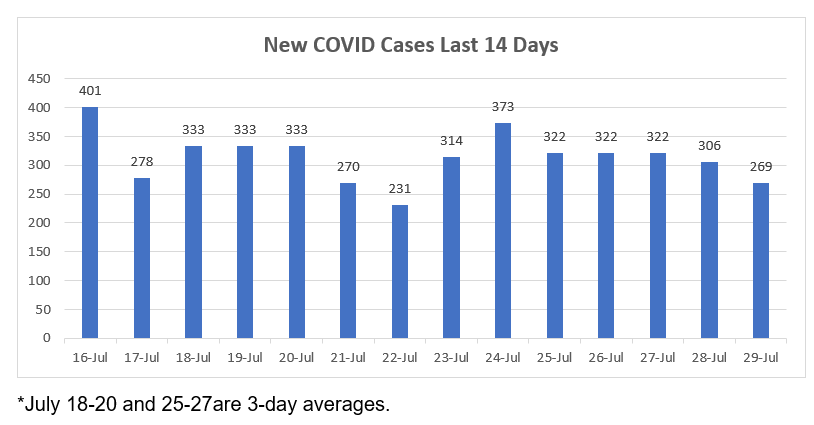

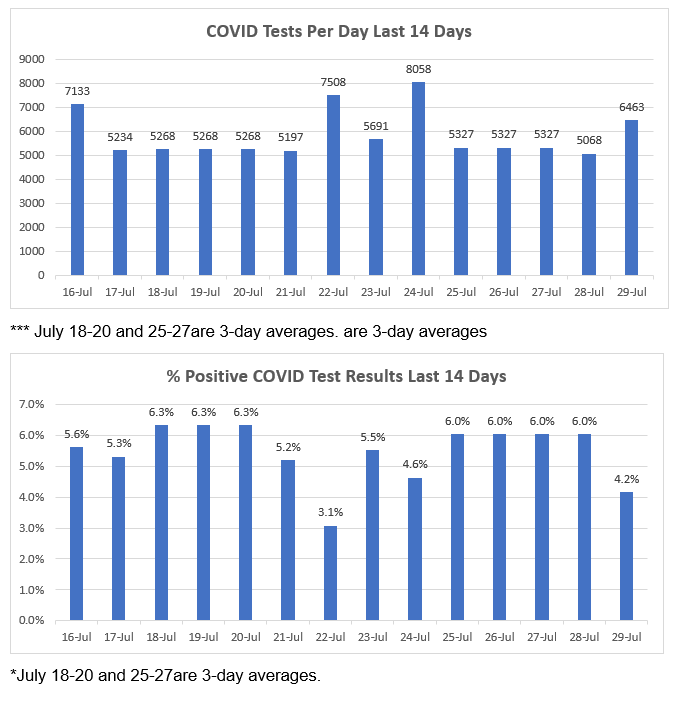

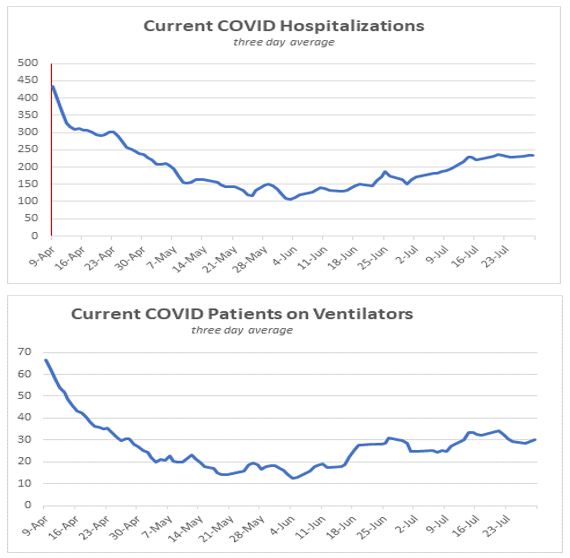
Want to See Past Newsletters?
If there was COVID-related information in a past newsletter that you want to go back to, but find you’ve deleted it, you can always go to my legislative website (www.senatordembrow.com), click on “News and Information,” and you’ll find them all there. Also, if someone forwarded you this newsletter and you’d like to get it directly, you can sign up for it there.
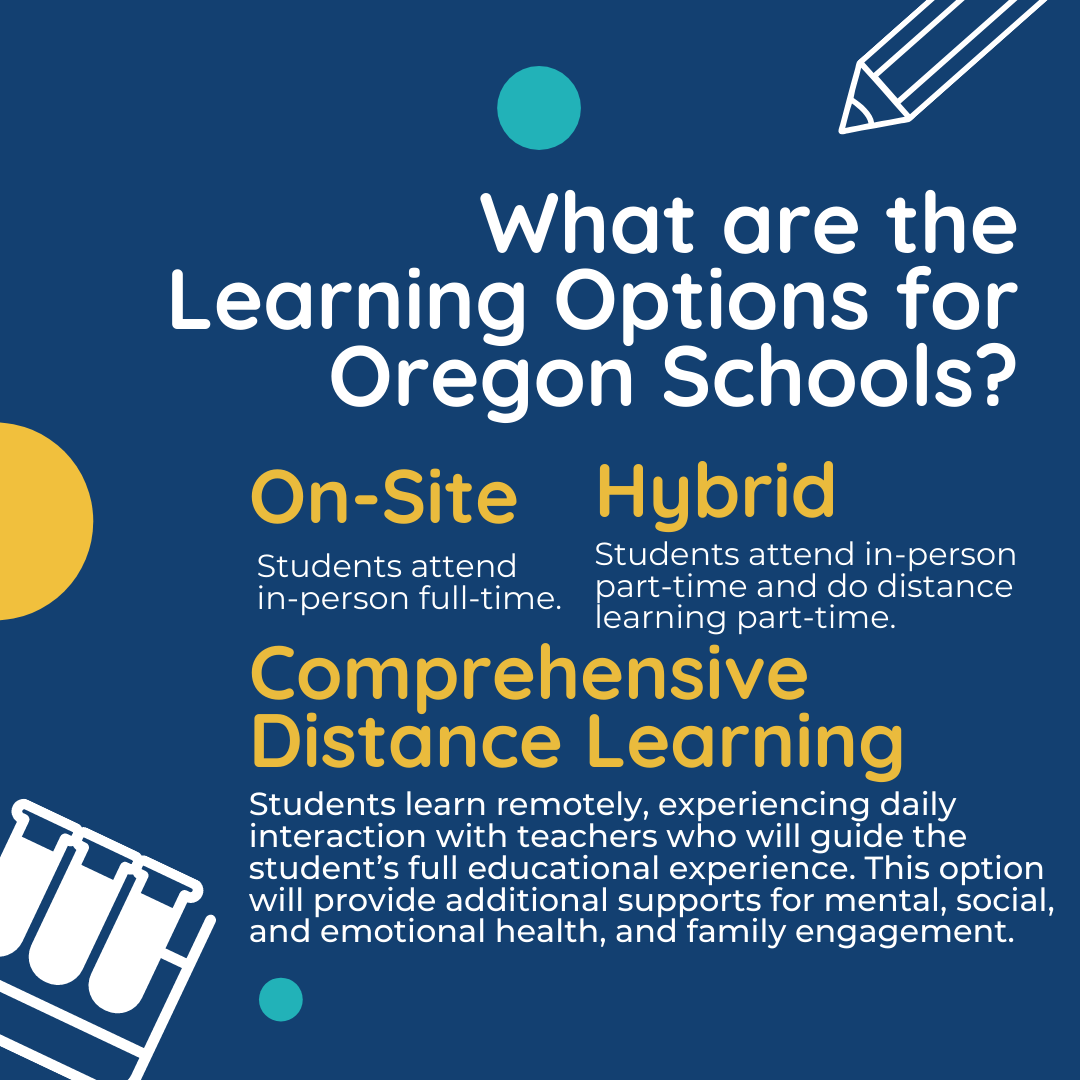
AND FINALLY,
Here again are some resources that you will find useful:
If the above links are not providing you with answers to your questions or directing you to the help that you need, please consider me and my office to be a resource. We’ll do our best to assist you or steer you in the right direction.
Best,
 Senator Michael Dembrow
District 23
email: Sen.MichaelDembrow@oregonlegislature.gov
web: www.senatordembrow.com
phone: 503-986-1723
mail: 900 Court St NE, S-407, Salem, OR, 97301
|